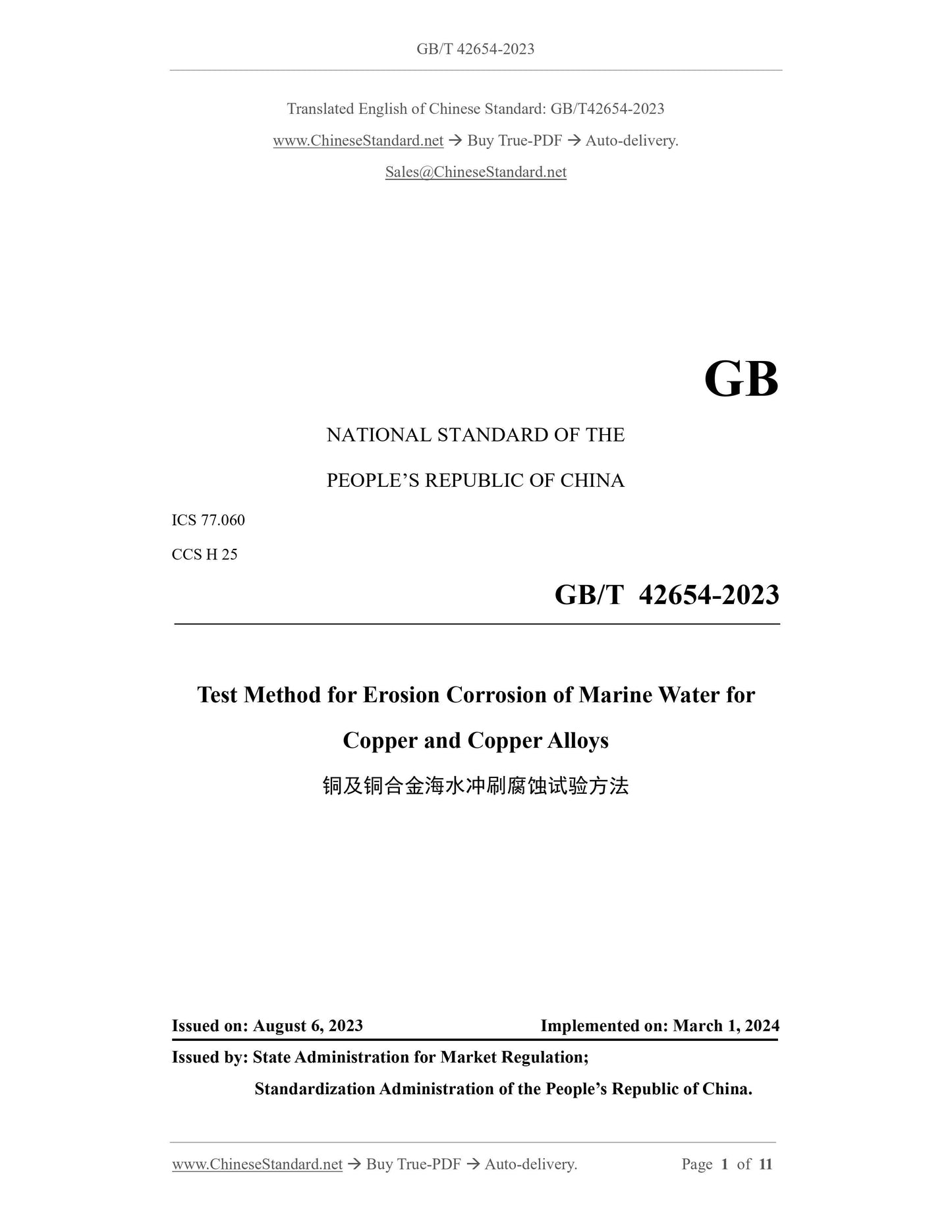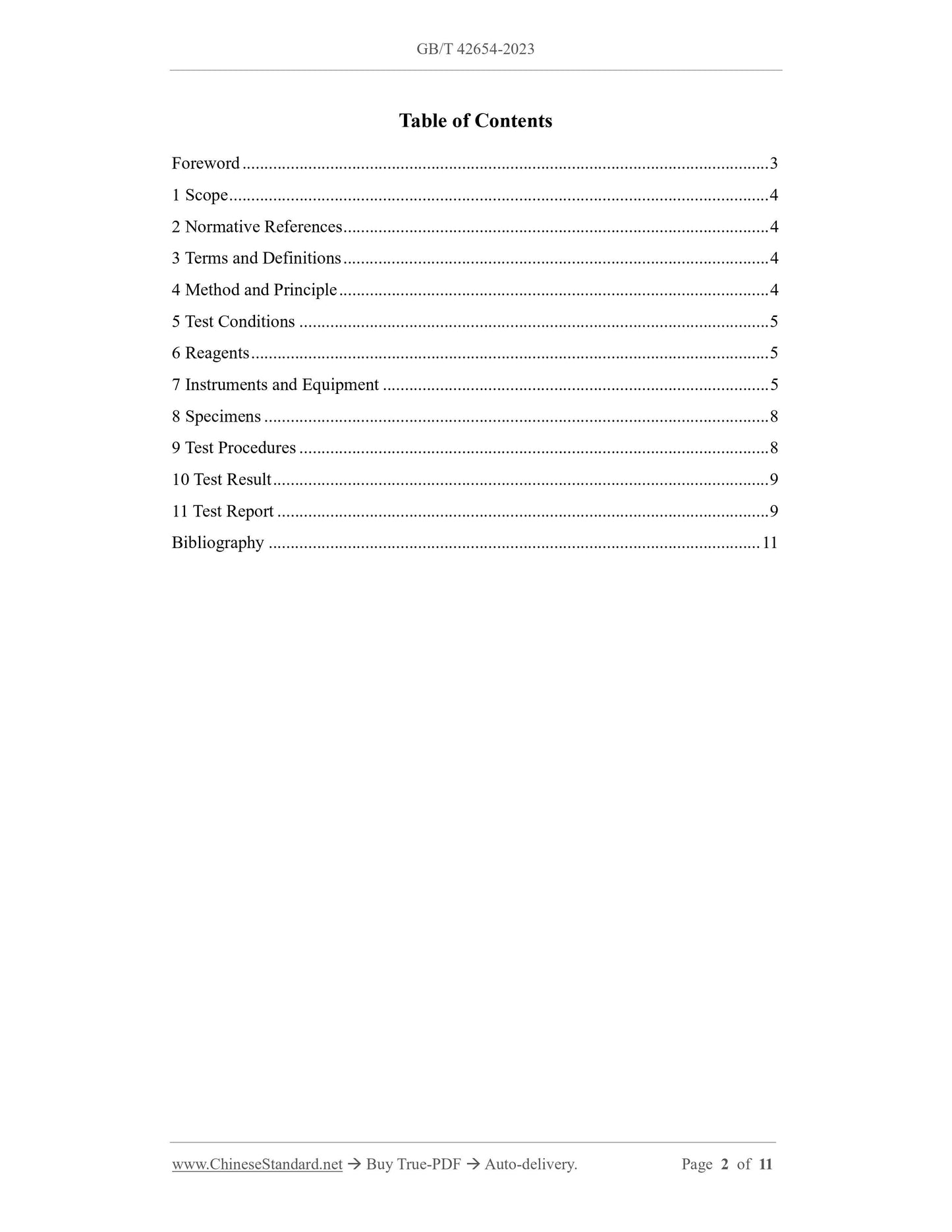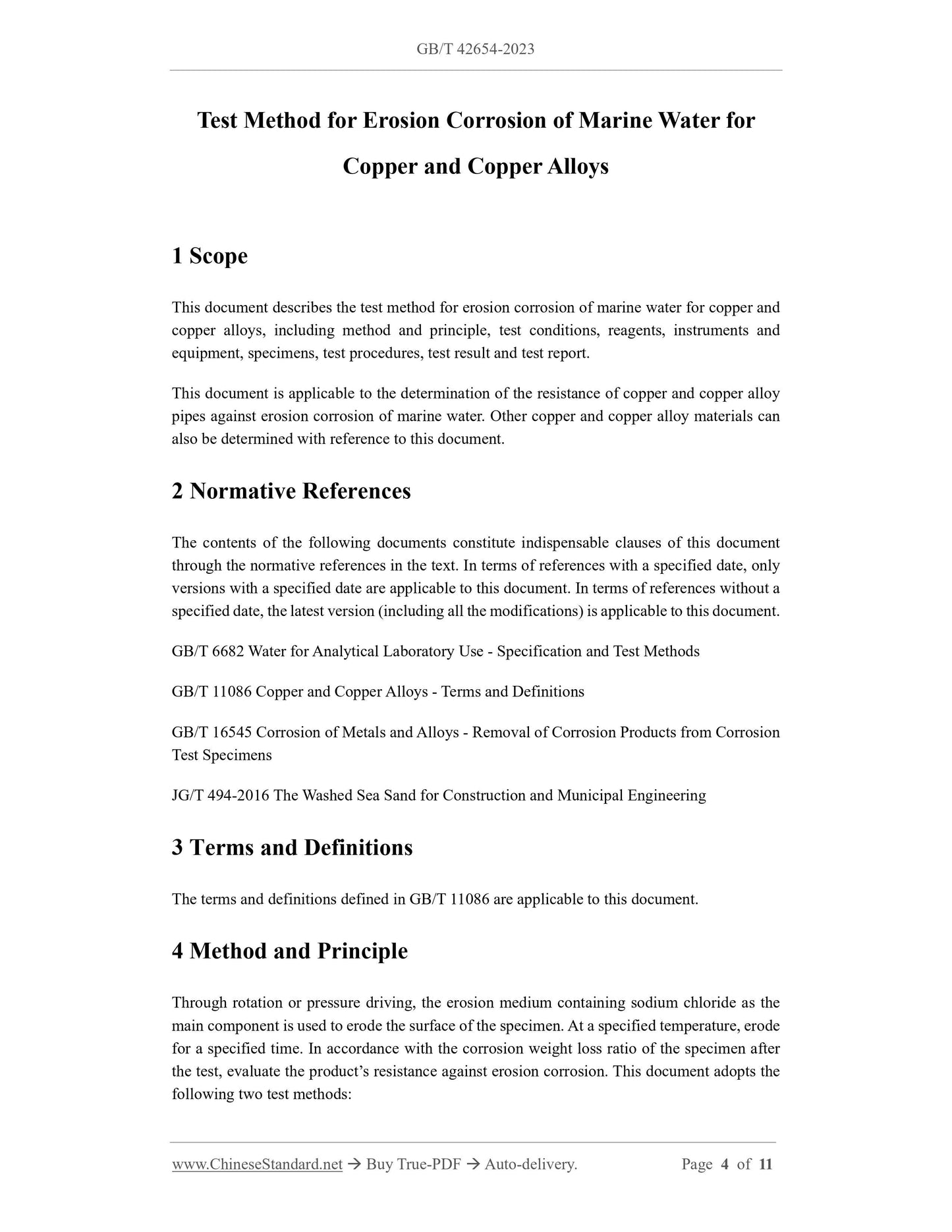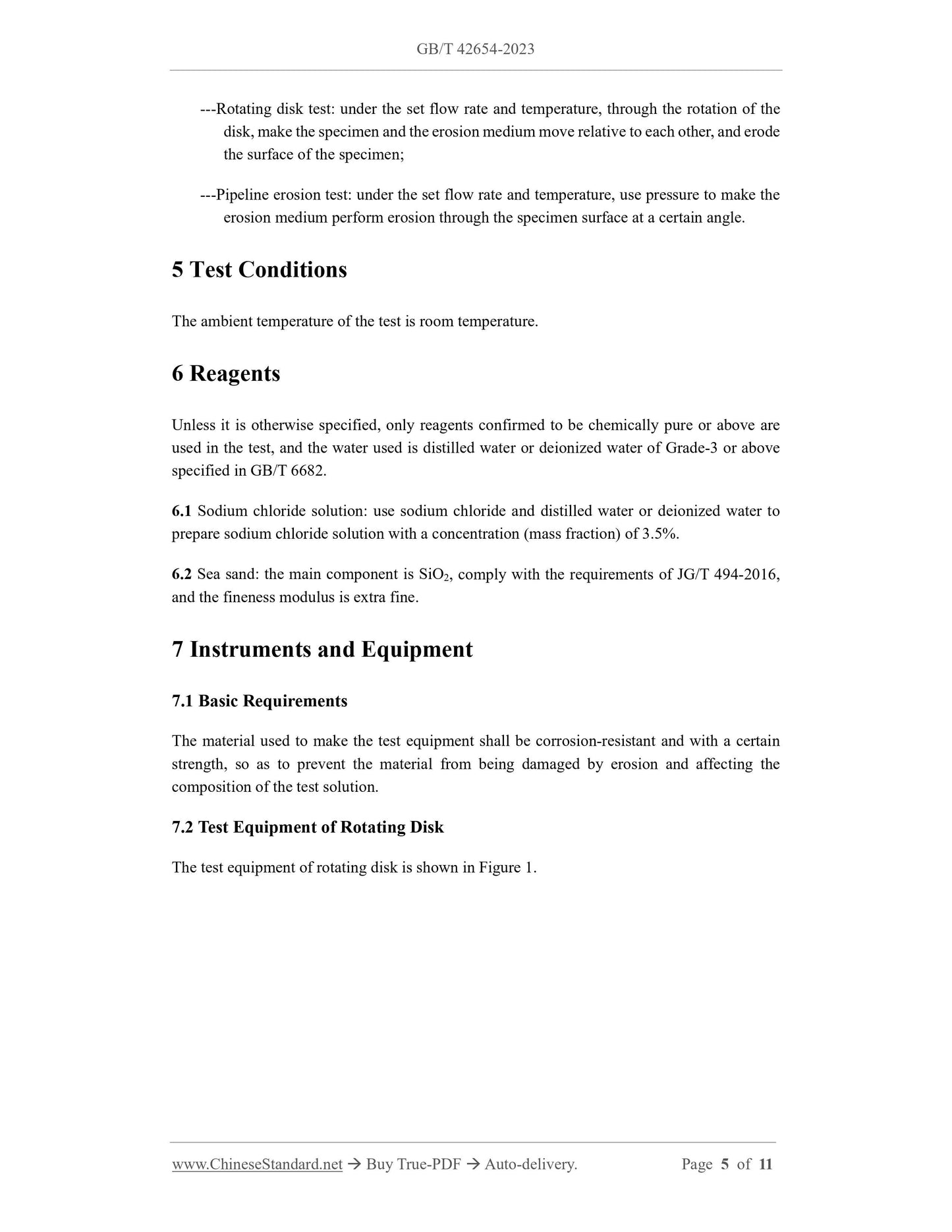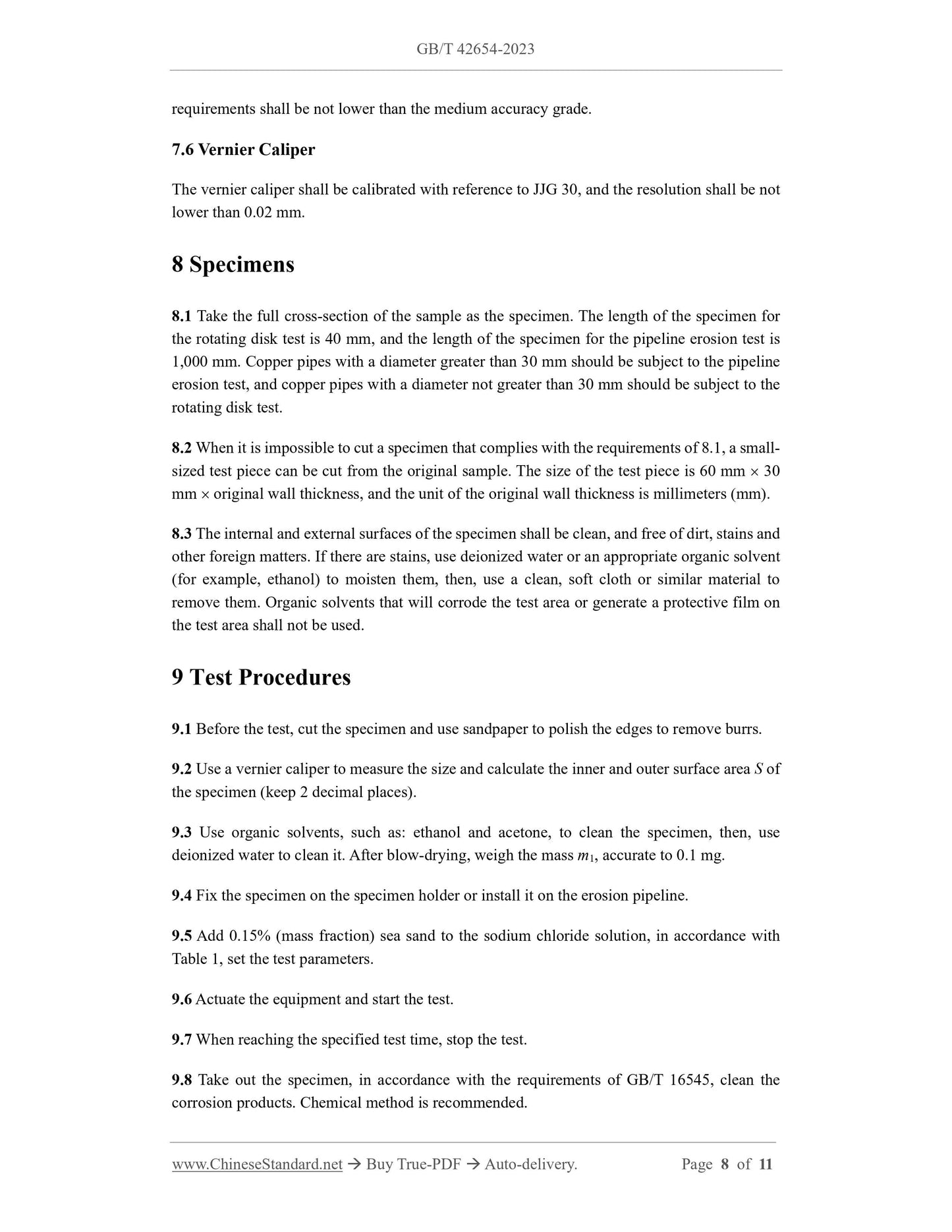1
/
of
5
PayPal, credit cards. Download editable-PDF and invoice in 1 second!
GB/T 42654-2023 English PDF (GB/T42654-2023)
GB/T 42654-2023 English PDF (GB/T42654-2023)
Regular price
$165.00 USD
Regular price
Sale price
$165.00 USD
Unit price
/
per
Shipping calculated at checkout.
Couldn't load pickup availability
Delivery: 3 seconds. Download true-PDF + Invoice.
Get QUOTATION in 1-minute: Click GB/T 42654-2023
Historical versions: GB/T 42654-2023
Preview True-PDF (Reload/Scroll if blank)
GB/T 42654-2023: Test method for erosion corrosion of marine water for copper and copper alloys
GB/T 42654-2023
GB
NATIONAL STANDARD OF THE
PEOPLE’S REPUBLIC OF CHINA
ICS 77.060
CCS H 25
Test Method for Erosion Corrosion of Marine Water for
Copper and Copper Alloys
ISSUED ON: AUGUST 6, 2023
IMPLEMENTED ON: MARCH 1, 2024
Issued by: State Administration for Market Regulation;
Standardization Administration of the People’s Republic of China.
Table of Contents
Foreword ... 3
1 Scope ... 4
2 Normative References ... 4
3 Terms and Definitions ... 4
4 Method and Principle ... 4
5 Test Conditions ... 5
6 Reagents ... 5
7 Instruments and Equipment ... 5
8 Specimens ... 8
9 Test Procedures ... 8
10 Test Result ... 9
11 Test Report ... 9
Bibliography ... 11
Test Method for Erosion Corrosion of Marine Water for
Copper and Copper Alloys
1 Scope
This document describes the test method for erosion corrosion of marine water for copper and
copper alloys, including method and principle, test conditions, reagents, instruments and
equipment, specimens, test procedures, test result and test report.
This document is applicable to the determination of the resistance of copper and copper alloy
pipes against erosion corrosion of marine water. Other copper and copper alloy materials can
also be determined with reference to this document.
2 Normative References
The contents of the following documents constitute indispensable clauses of this document
through the normative references in the text. In terms of references with a specified date, only
versions with a specified date are applicable to this document. In terms of references without a
specified date, the latest version (including all the modifications) is applicable to this document.
GB/T 6682 Water for Analytical Laboratory Use - Specification and Test Methods
GB/T 11086 Copper and Copper Alloys - Terms and Definitions
GB/T 16545 Corrosion of Metals and Alloys - Removal of Corrosion Products from Corrosion
Test Specimens
JG/T 494-2016 The Washed Sea Sand for Construction and Municipal Engineering
3 Terms and Definitions
The terms and definitions defined in GB/T 11086 are applicable to this document.
4 Method and Principle
Through rotation or pressure driving, the erosion medium containing sodium chloride as the
main component is used to erode the surface of the specimen. At a specified temperature, erode
for a specified time. In accordance with the corrosion weight loss ratio of the specimen after
the test, evaluate the product’s resistance against erosion corrosion. This document adopts the
following two test methods:
---Rotating disk test: under the set flow rate and temperature, through the rotation of the
disk, make the specimen and the erosion medium move relative to each other, and erode
the surface of the specimen;
---Pipeline erosion test: under the set flow rate and temperature, use pressure to make the
erosion medium perform erosion through the specimen surface at a certain angle.
5 Test Conditions
The ambient temperature of the test is room temperature.
6 Reagents
Unless it is otherwise specified, only reagents confirmed to be chemically pure or above are
used in the test, and the water used is distilled water or deionized water of Grade-3 or above
specified in GB/T 6682.
6.1 Sodium chloride solution: use sodium chloride and distilled water or deionized water to
prepare sodium chloride solution with a concentration (mass fraction) of 3.5%.
6.2 Sea sand: the main component is SiO2, comply with the requirements of JG/T 494-2016,
and the fineness modulus is extra fine.
7 Instruments and Equipment
7.1 Basic Requirements
The material used to make the test equipment shall be corrosion-resistant and with a certain
strength, so as to prevent the material from being damaged by erosion and affecting the
composition of the test solution.
7.2 Test Equipment of Rotating Disk
The test equipment of rotating disk is shown in Figure 1.
requirements shall be not lower than the medium accuracy grade.
7.6 Vernier Caliper
The vernier caliper shall be calibrated with reference to JJG 30, and the resolution shall be not
lower than 0.02 mm.
8 Specimens
8.1 Take the full cross-section of the sample as the specimen. The length of the specimen for
the rotating disk test is 40 mm, and the length of the specimen for the pipeline erosion test is
1,000 mm. Copper pipes with a diameter greater than 30 mm should be subject to the pipeline
erosion test, and copper pipes with a diameter not greater than 30 mm should be subject to the
rotating disk test.
8.2 When it is impossible to cut a specimen that complies with the requirements of 8.1, a small-
sized test piece can be cut from the original sample. The size of the test piece is 60 mm 30
mm original wall thickness, and the unit of the original wall thickness is millimeters (mm).
8.3 The internal and external surfaces of the specimen shall be clean, and free of dirt, stains and
other foreign matters. If there are stains, use deionized water or an appropriate organic solvent
(for example, ethanol) to moisten them, then, use a clean, soft cloth or similar material to
remove them. Organic solvents that will corrode the test area or generate a protective film on
the test area shall not be used.
9 Test Procedures
9.1 Before the test, cut the specimen and use sandpaper to polish the edges to remove burrs.
9.2 Use a vernier caliper to measure the size and calculate the inner and outer surface area S of
the specimen (keep 2 decimal places).
9.3 Use organic solvents, such as: ethanol and acetone, to clean the specimen, then, use
deionized water to clean it. After blow-drying, weigh the mass m1, accurate to 0.1 mg.
9.4 Fix the specimen on the specimen holder or install it on the erosion pipeline.
9.5 Add 0.15% (mass fraction) sea sand to the sodium chloride solution, in accordance with
Table 1, set the test parameters.
9.6 Actuate the equipment and start the test.
9.7 When reaching the specified test time, stop the test.
9.8 Take out the specimen, in accordance with the requirements of GB/T 16545, clean the
corrosion products. Chemical method is recommended.
Get QUOTATION in 1-minute: Click GB/T 42654-2023
Historical versions: GB/T 42654-2023
Preview True-PDF (Reload/Scroll if blank)
GB/T 42654-2023: Test method for erosion corrosion of marine water for copper and copper alloys
GB/T 42654-2023
GB
NATIONAL STANDARD OF THE
PEOPLE’S REPUBLIC OF CHINA
ICS 77.060
CCS H 25
Test Method for Erosion Corrosion of Marine Water for
Copper and Copper Alloys
ISSUED ON: AUGUST 6, 2023
IMPLEMENTED ON: MARCH 1, 2024
Issued by: State Administration for Market Regulation;
Standardization Administration of the People’s Republic of China.
Table of Contents
Foreword ... 3
1 Scope ... 4
2 Normative References ... 4
3 Terms and Definitions ... 4
4 Method and Principle ... 4
5 Test Conditions ... 5
6 Reagents ... 5
7 Instruments and Equipment ... 5
8 Specimens ... 8
9 Test Procedures ... 8
10 Test Result ... 9
11 Test Report ... 9
Bibliography ... 11
Test Method for Erosion Corrosion of Marine Water for
Copper and Copper Alloys
1 Scope
This document describes the test method for erosion corrosion of marine water for copper and
copper alloys, including method and principle, test conditions, reagents, instruments and
equipment, specimens, test procedures, test result and test report.
This document is applicable to the determination of the resistance of copper and copper alloy
pipes against erosion corrosion of marine water. Other copper and copper alloy materials can
also be determined with reference to this document.
2 Normative References
The contents of the following documents constitute indispensable clauses of this document
through the normative references in the text. In terms of references with a specified date, only
versions with a specified date are applicable to this document. In terms of references without a
specified date, the latest version (including all the modifications) is applicable to this document.
GB/T 6682 Water for Analytical Laboratory Use - Specification and Test Methods
GB/T 11086 Copper and Copper Alloys - Terms and Definitions
GB/T 16545 Corrosion of Metals and Alloys - Removal of Corrosion Products from Corrosion
Test Specimens
JG/T 494-2016 The Washed Sea Sand for Construction and Municipal Engineering
3 Terms and Definitions
The terms and definitions defined in GB/T 11086 are applicable to this document.
4 Method and Principle
Through rotation or pressure driving, the erosion medium containing sodium chloride as the
main component is used to erode the surface of the specimen. At a specified temperature, erode
for a specified time. In accordance with the corrosion weight loss ratio of the specimen after
the test, evaluate the product’s resistance against erosion corrosion. This document adopts the
following two test methods:
---Rotating disk test: under the set flow rate and temperature, through the rotation of the
disk, make the specimen and the erosion medium move relative to each other, and erode
the surface of the specimen;
---Pipeline erosion test: under the set flow rate and temperature, use pressure to make the
erosion medium perform erosion through the specimen surface at a certain angle.
5 Test Conditions
The ambient temperature of the test is room temperature.
6 Reagents
Unless it is otherwise specified, only reagents confirmed to be chemically pure or above are
used in the test, and the water used is distilled water or deionized water of Grade-3 or above
specified in GB/T 6682.
6.1 Sodium chloride solution: use sodium chloride and distilled water or deionized water to
prepare sodium chloride solution with a concentration (mass fraction) of 3.5%.
6.2 Sea sand: the main component is SiO2, comply with the requirements of JG/T 494-2016,
and the fineness modulus is extra fine.
7 Instruments and Equipment
7.1 Basic Requirements
The material used to make the test equipment shall be corrosion-resistant and with a certain
strength, so as to prevent the material from being damaged by erosion and affecting the
composition of the test solution.
7.2 Test Equipment of Rotating Disk
The test equipment of rotating disk is shown in Figure 1.
requirements shall be not lower than the medium accuracy grade.
7.6 Vernier Caliper
The vernier caliper shall be calibrated with reference to JJG 30, and the resolution shall be not
lower than 0.02 mm.
8 Specimens
8.1 Take the full cross-section of the sample as the specimen. The length of the specimen for
the rotating disk test is 40 mm, and the length of the specimen for the pipeline erosion test is
1,000 mm. Copper pipes with a diameter greater than 30 mm should be subject to the pipeline
erosion test, and copper pipes with a diameter not greater than 30 mm should be subject to the
rotating disk test.
8.2 When it is impossible to cut a specimen that complies with the requirements of 8.1, a small-
sized test piece can be cut from the original sample. The size of the test piece is 60 mm 30
mm original wall thickness, and the unit of the original wall thickness is millimeters (mm).
8.3 The internal and external surfaces of the specimen shall be clean, and free of dirt, stains and
other foreign matters. If there are stains, use deionized water or an appropriate organic solvent
(for example, ethanol) to moisten them, then, use a clean, soft cloth or similar material to
remove them. Organic solvents that will corrode the test area or generate a protective film on
the test area shall not be used.
9 Test Procedures
9.1 Before the test, cut the specimen and use sandpaper to polish the edges to remove burrs.
9.2 Use a vernier caliper to measure the size and calculate the inner and outer surface area S of
the specimen (keep 2 decimal places).
9.3 Use organic solvents, such as: ethanol and acetone, to clean the specimen, then, use
deionized water to clean it. After blow-drying, weigh the mass m1, accurate to 0.1 mg.
9.4 Fix the specimen on the specimen holder or install it on the erosion pipeline.
9.5 Add 0.15% (mass fraction) sea sand to the sodium chloride solution, in accordance with
Table 1, set the test parameters.
9.6 Actuate the equipment and start the test.
9.7 When reaching the specified test time, stop the test.
9.8 Take out the specimen, in accordance with the requirements of GB/T 16545, clean the
corrosion products. Chemical method is recommended.
Share
